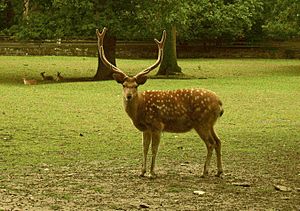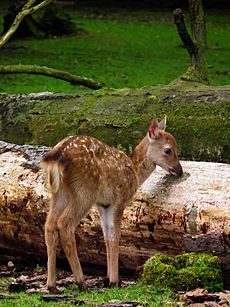Sika deer facts for kids
Quick facts for kids Sika deer |
|
|---|---|
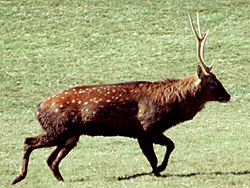 |
|
| Male (stag) | |
 |
|
| Females (hinds) | |
| Conservation status | |
| Scientific classification | |
| Kingdom: | |
| Class: | |
| Order: | |
| Family: | |
| Subfamily: |
Cervinae
|
| Genus: |
Cervus
|
| Binomial name | |
| Cervus nippon |
|
The sika deer (Cervus nippon) is a member of the deer family Cervidae. It lives in East Asia. It is found in mixed deciduous forests to the north, and mixed subtropical deciduous and evergreen forests to the south.
Contents
Description
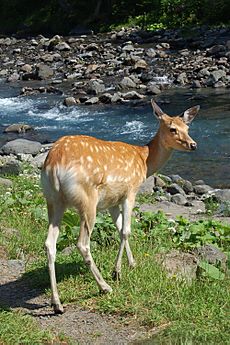
The sika deer is one of the few deer species that does not lose its spots upon reaching maturity. Spot patterns vary with region. The mainland subspecies have larger and more obvious spots, in contrast to the Taiwanese and Japanese subspecies, whose spots are nearly invisible. Many introduced populations are from Japan, so they also lack significant spots.
The color of the pelage ranges from mahogany to black, and white individuals are also known. During winter, the coat becomes darker and shaggier and the spots less prominent, and a mane forms on the back of the males' necks. They are medium-sized herbivores, though they show notable size variation across their several subspecies and considerable sexual dimorphism, with males invariably much larger than females. They can vary from 50 to 110 cm (20 to 43 in) tall at the shoulder and from 95 to 180 cm (37 to 71 in) in head-and-body length. The tail measures about 7.5–13 cm (3.0–5.1 in) long.
The largest subspecies is the Manchurian sika deer (C. n. mantchuricus), in which males commonly weigh about 68–109 kg (150–240 lb) and females weigh 45–50 kg (99–110 lb), with large stags scaling up to 160 kg (350 lb). On the other end of the size spectrum, in the Japanese sika deer (C. n. nippon), males weigh 40–70 kg (88–154 lb) and females weigh 30–40 kg (66–88 lb). All sikas are compact and dainty-legged, with short, trim, wedge-shaped heads and a boisterous disposition. When alarmed, they often display a distinctive flared rump, much like the American elk.
Sika stags have stout, upright antlers with an extra buttress up from the brow tine and a very thick wall. A forward-facing intermediate tine breaks the line to the top, which is usually forked. Occasionally, sika antlers develop some palmation (flat areas). Females carry a pair of distinctive black bumps on the forehead. Antlers can range from 28 to 45 cm (11 to 18 in) to more than 80 cm (30 in), depending on the subspecies. Stags also have distinctive manes during their mating period (rut).
Behavior
Sika deer can be active throughout the day, though in areas with heavy human disturbance, they tend to be nocturnal. Seasonal migration is known to occur in mountainous areas, such as Japan, with winter ranges being up to 700 m (2,300 ft) lower in elevation than summer ranges.
Lifestyles vary between individuals, with some occurring alone while others are found in single-sex groups. Large herds gather in autumn and winter. Males spend most years alone occasionally forming herds together. Females with fawns only form herds during birthing season. The sika deer is a highly vocal species, with over 10 individual sounds, ranging from soft whistles to loud screams.
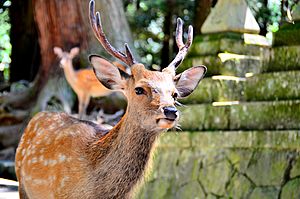
Sika males are territorial and keep harems of females during their rut, which peaks from early September through October, but may last well into the winter. Territory size varies with habitat type and size of the buck; strong, prime bucks may hold up to 2 ha (5 acres). Territories are marked by a series of shallow pits or "scrapes", which is digging holes (up to 1.6m in wide and 0.3m in deep) with forefeet or antlers, into which the males urinate and from which emanates a strong, musky odor. Fights between rival males for territorial disputes, which occur by using hooves and antlers, are sometimes fierce and long and may even be fatal.
The gestation period lasts for 7 months. Hinds (does) give birth to a single fawn, weighing 4.5 to 7 kg (9.9 to 15.4 lb), which is nursed for up to 10 months. The mother hides her baby in thick undergrowth since immediately given birth, with fawn stays very quiet and still while it waits until the mother is return for nursing. Hinds (does) give birth to a single fawn, weighing 4.5 to 7 kg (9.9 to 15.4 lb), which is nursed for up to 10 months. The fawn becomes independent 10 to 12 months after birth, and attains sexual maturity at 16 to 18 months in both sexes. The average lifespan is 15 to 18 years in captivity, although one case is recorded as living 25 years and 5 months.
The sika deer may interbreed with the red deer, the closest relative; hybrid descendants may have adaptive advantages over purebred relatives.
In Nara Prefecture, Japan, the deer are also known as "bowing deer", as they bow their heads before being fed special shika senbei (鹿せんべい, called "deer cookies"). However, deer bow heads to signal that they are about to headbutt. Therefore, when a human 'bows' to a deer, the deer assume the same stance and may charge and injure the human. Deer headbutt both for play and to assert dominance, as do goats. Sika deer are found throughout the city of Nara and its many parks and temples like Tōdai-ji, as they are considered to be the messengers of the Shinto gods.
Habitat
Sika deer are found in the temperate and subtropical forests of eastern Asia, preferring areas with dense understory, and where snowfall does not exceed 10–20 cm (3.9–7.9 in). They tend to forage in patchy clearings of forests. Introduced populations are found in areas with similar habitats to their native ranges, including Western and Central Europe, Eastern United States, and New Zealand.
Images for kids
-
Tsukioka Yoshitoshi ukiyo-e depicting the Minamoto no Tsunemoto hunting a sika with a yumi
-
The skull of stag displayed in the Finnish Museum of Natural History, Helsinki, Finland
See also
 In Spanish: Cervus nippon para niños
In Spanish: Cervus nippon para niños



